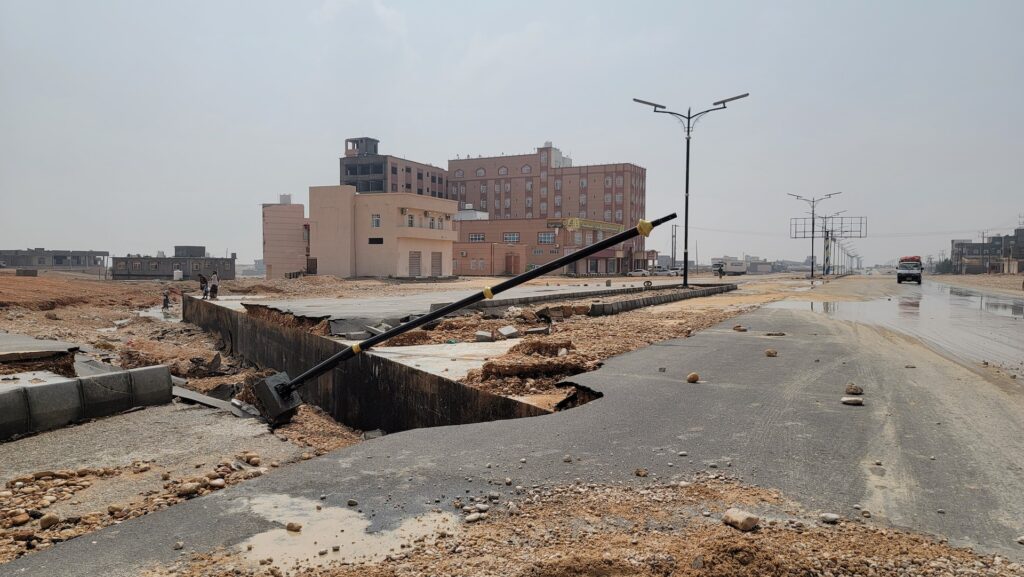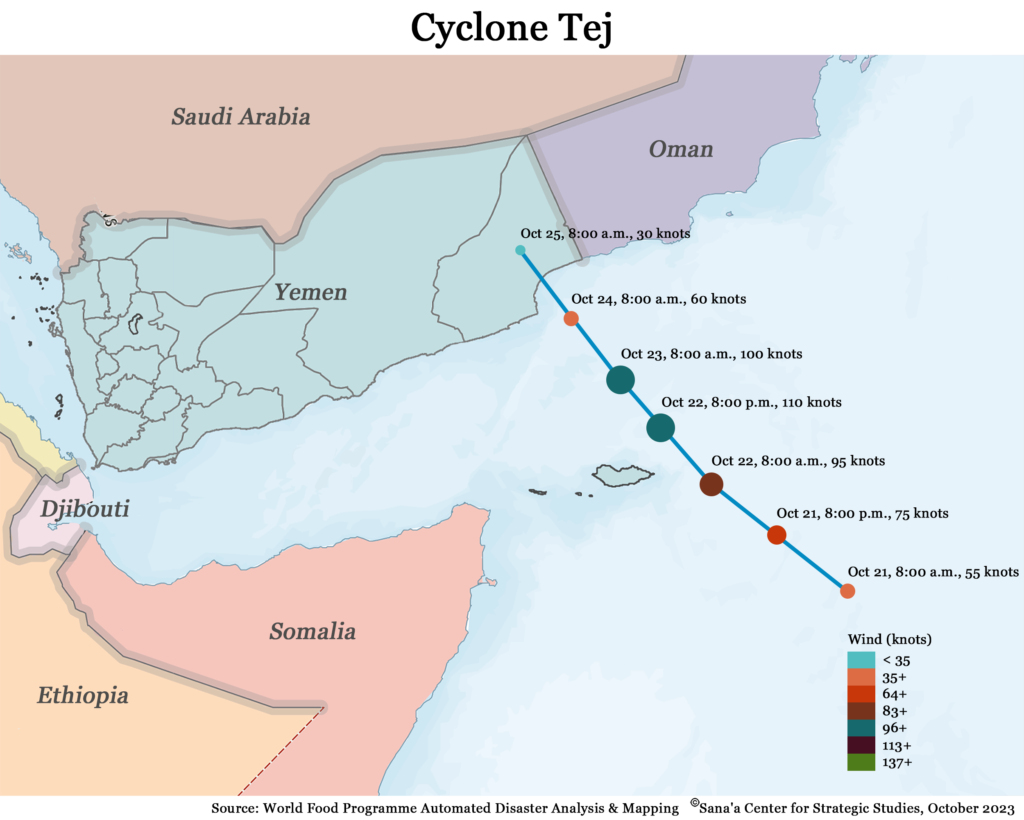Cyclone Tej struck Yemen in the last week of October, ripping through the archipelago of Socotra, making landfall in the governorate of Al-Mahra, and wreaking havoc in Hadramawt, Shabwa, and Al-Dhalea. The cyclone brought rainfall and severe flooding, destroyed homes and roads, cut off electricity and communication networks, and displaced thousands of families. According to the Yemen Red Crescent Society, over 35,000 households were impacted by the latest cyclone to hit Yemen.
Cyclones in Yemen have increased in frequency, posing serious risks to vulnerable coastal populations and infrastructure. In the past six years alone, whilst grappling with an almost decade-long conflict, Yemen was hit by six cyclones, compared to only four in the preceding 25 years. An increase in extreme climatic events has led to significant loss of Yemeni lives and livelihoods, worsening food insecurity and leading many local communities to leave their lands and homes. The high number of internally displaced people, meanwhile, has further strained already limited national resources.
Today, Yemen stands as the 22nd most vulnerable country to climate change, ranking 171 out of 181 countries on the 2022 Global Adaptation Index, and 12th least prepared to adapt to climate change. It is simultaneously one of the least climate-funded countries globally, despite contributing less than 0.03 percent of total global greenhouse gas emissions.
As all eyes will be on COP 28 in Dubai at the end of November, Cyclone Tej serves as an important reminder to the world of the climate threats faced by Yemenis today, and the country’s critical need for support in adapting to climate change.
Cyclone Tej Brings Damage and Devastation
Cyclone Tej passed through Socotra, making its way to the governorate of Al-Mahra on October 22, leading to intense rainfall and sea level rise. On October 23, it made landfall on Al-Mahra’s southern coast, with the Yemeni Meteorological Authority reporting over 406 mm of rainfall at the capital’s airport in the space of just a few hours, dwarfing the annual average rainfall of 50 mm. Continuing north, on October 24, wind gusts reached 50-60 knots. The cyclone eventually weakened to a tropical depression, but heavy rainfall continued over other parts of Yemen.
On Socotra, a UN agency indicated that the cyclone destroyed or damaged over 500 homes. Although there were no reported casualties, the storm caused significant material damage to infrastructure, public and private property, and citizens’ homes, with around 50 percent of roads destroyed, especially in eastern areas. Areas like Ras Irsaal were left completely cut off, with no road linking it to the capital Hadibu.
In Al-Mahra, where the eye of the storm made landfall, the cyclone killed two people, left six people missing, and displaced over 10,000 from Al-Ghaydah and Al-Haswain districts. The cyclone caused flooding that submerged roads and vehicles and damaged numerous buildings. The Yemeni Red Crescent said over 1,800 families were displaced across Al-Mahra. Torrential rains and flooding also left a wake of destruction in Abyan, Shabwa, and Hadramawt. In some areas of Al-Dhalea, roads were cut off as torrential rainwater inundated residents for four consecutive days, preventing them from accessing food and emergency medical care.
On Sunday, October 22, Rashad al-Alimi, the head of Yemen’s Presidential Leadership Council, visited Al-Mahra, urging the government and local authorities to ramp up efforts to mitigate the cyclone’s effects, and instructing coordination between responding agencies, including military and security authorities, community committees, as well as regional and international organizations. Al-Mahra’s authorities set up 45 centers to shelter more than 1,300 families who were displaced by the cyclone, as public and private schools ground to a halt. Al-Mahra, however, lacks cohesive infrastructure to protect against natural disasters. This makes it difficult to forecast and prepare for natural disasters, jeopardizing the lives of vulnerable communities that are increasingly at risk as climate change causes more frequent, extreme, and unpredictable weather.

Yemen’s Increasing Vulnerability to Climate Shocks
Many Yemeni communities are dependent on climate-sensitive practices such as farming and fishing for their livelihoods. This high dependence on natural resources leaves them highly exposed to climate shocks. Farmers in Yemen have seen their livelihoods destroyed by extreme drought and flooding, pushing them to the brink and making it harder to make ends meet. Yemen is also one of the world’s most water-scarce countries, and one of the most food insecure, with 80 percent of the population struggling to access food and drinking water. The effects of climate change, including increased droughts, cyclones, and flash floods in recent years, have exacerbated the problem, leading to declining agricultural yields, loss of lands, and worsening Yemenis’ access to clean water sources.
As communities have started to lose the natural resources essential for meeting their basic needs, they are becoming more vulnerable to exploitation and human rights abuses. These vulnerabilities are compounded by the current conflict, which has strained aging infrastructure and increased density, hampering effective disaster response. In rural areas, which are the hardest hit by climate stresses, some families have resorted to harmful coping strategies. These include pulling children from school to work, or in some cases, children even being forced into early marriage or child labor to help meet basic needs. Since the outbreak of the conflict, armed groups have exploited this situation by recruiting from the growing number of internally displaced people, including children and unemployed climate migrants. Limited access to essential services and fragile healthcare systems, in turn, exacerbate the dire repercussions of extreme climatic events. In the absence of a robust national environmental management strategy and early warning for climate threats, competition over scarce resources is likely to increase tensions and the potential for new conflicts to erupt.
COP28 Must Take Note of Yemen’s Climate Plight
Cyclone Tej is a harbinger of things to come. The increasing frequency and severity of extreme weather events underscores the urgency of addressing climate change in Yemen. The upcoming COP28 climate conference, held in Dubai at the end of this month, represents a vital opportunity for the international community to ramp up climate action and support for vulnerable countries like Yemen. It also offers the chance to mobilize international support and financing for climate adaptation, which can lessen the impact of future natural disasters, while fostering stability and development in Yemen.
Yemen’s delegation to COP28, alongside representatives from Yemeni civil society organizations and local communities, must ensure the gathering nations understand the severity of Yemen’s climate crisis and climate-related peace and security risks highlighted in negotiations at the conference. COP 28 should be used as a platform to coordinate adaptation efforts and climate finance by forging partnerships between national authorities, regional and international entities, and global leaders.
While working on the global stage, Yemen must also pursue a domestic climate reckoning. The country’s lack of national climate strategies, plans, and policies compounds its current crisis. Outdated infrastructure will not be able to withstand accelerating climate impacts. The decade-long conflict has also prevented knowledge and technology transfer and restricted fruitful cooperation with international agencies. Yemen must rally internal political support to directly meet the coming climate crisis. Alongside that domestic agenda, Yemen urgently needs sustained international assistance across the humanitarian-development-peace nexus to strengthen national and local capacity to cope with climate shocks. Such support must focus on enhancing climate risk governance, preparedness, early warning and monitoring systems, social safety nets, infrastructure upgrades, and climate-smart agriculture.

 اقرأ المحتوى باللغة العربية
اقرأ المحتوى باللغة العربية
